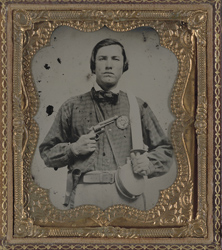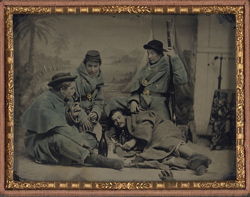The following is a guest post by Helena Zinkham, Chief, Prints & Photographs Division

Private David C. Colbert of Company C, 46th Virginia Infantry Regiment. http://hdl.loc.gov/loc.pnp/ppmsca.32064
When you look at a soldier’s portrait from the American Civil War, have you ever wondered what that particular person, or his regiment, experienced? For twenty of the Union and Confederate soldiers whose names survived with their photographs in the Liljenquist Collection, you can now get a glimpse of their lives.
You’ll find many different stories among these photos, though most of the soldiers were wounded, taken prisoner, killed by enemy or friendly fire, or died from disease, like David Colbert (shown here). A few, including John Anthony, Charles Osgood, and Charles Sherman lived long after the war, into the 1920s. Several photographs show brothers who went to war, including the Masons from Vermont and the Moores from Virginia. Among the men who fought on opposite sides at Chancellorsville and Gettysburg are the Ellsworths from New Hampshire and George Gaither from Maryland. The youngest soldier is the 14-year old Union drummer boy, George Weeks from Maine. One of the older men is a Confederate surgeon, Dr. Alexander Harris from Virginia.

Sergeant Cornelius V. Moore of Company B, 100th New York Volunteers, a sergeant of 39th Illinois Regiment, a corporal of 106th New York Volunteers, and a private of the 11th Vermont Regiment. http://hdl.loc.gov/loc.pnp/ppmsca.30571
Quotations from notes and letters found with the portraits provide some of the most interesting details. Cornelius Moore of New York wrote home after enlisting in 1863 to ask, “I hope you will find out whether we got to stay 3 years or 9 months.” Taken prisoner at Drewry’s Bluff and sent to the infamous prison at Andersonville, he survived to say, “I thought I would never see you again but there is hope now.” A letter from July 1865 requests an honorable discharge after the war, explaining that he had fulfilled his duty, “I entered the service when the government needed the services of its loyal citizens, to maintain its integrity, suppress secession and ensure its permanency.”
Teachers and students take special note! Looking directly into the faces of the people who fought the Civil War is a great doorway into history. These soldiers, often teenagers who look like people we might know in high school or college today, experienced terrible hardships. Their portraits provoke many questions about the past and also about our own lives. The biographical sketches begin to tell the stories of the men and their families, but many questions remain to be explored. And, the Liljenquist Collection now has more than eighty identified soldiers. You could try your own hand at researching and writing a soldier’s biography.
The Prints & Photographs Division extends a special thanks to Anne Moses Tyler, who wrote these biographical sketches while working at the Library of Congress in the summer of 2012 as the first Liljenquist Family Fellow from the Stanford in Government program. Tyler is a history major at Stanford University.
Learn More:
- Looking directly into the faces of the people who fought the Civil War is a great doorway into history. Glimpses of Soldiers’ Lives (Liljenquist Collection) presents a set of essays paired with portraits which offer glimpses of the lives of particular soldiers.
- Come face-to-face with Civil War soldiers and sailors in the Liljenquist Family Collection of Civil War Photographs.
- Visit an online exhibition The Last Full Measure which features 379 Civil War-era ambrotypes and tintypes of enlisted Union and Confederate soldiers from the Liljenquist Family Collection.
- Explore the faces, places and events of the U.S. Civil War through photographs, prints and drawings in Civil War resources in the Prints & Photographs Division
- A new exhibition, The Civil War in America, reveals the complex story of the war through those who experienced it first-hand.
